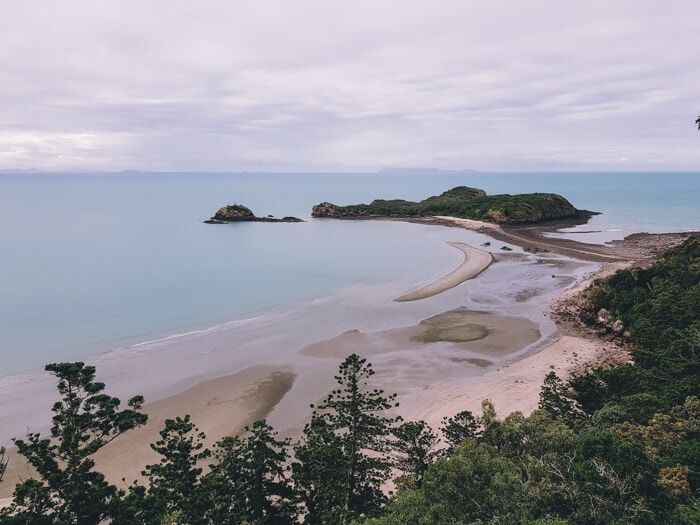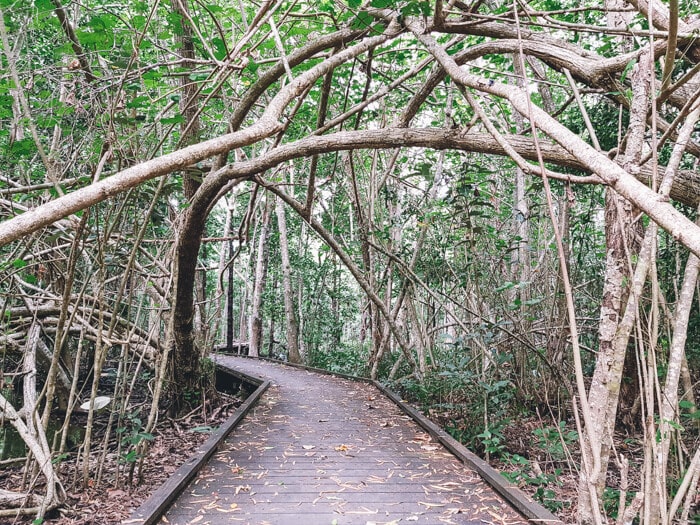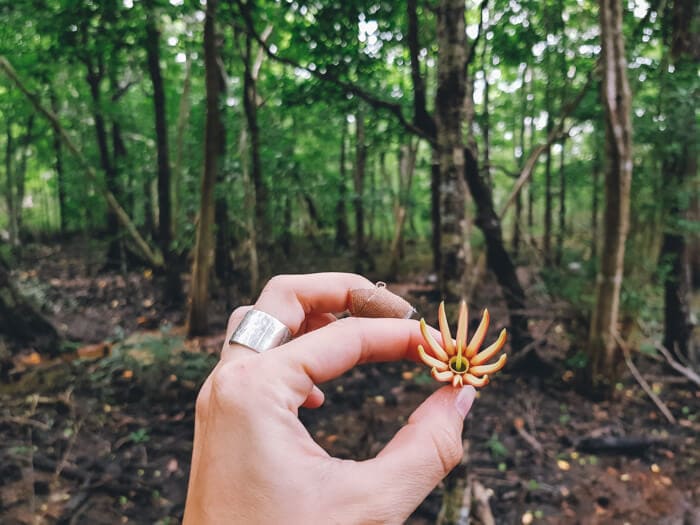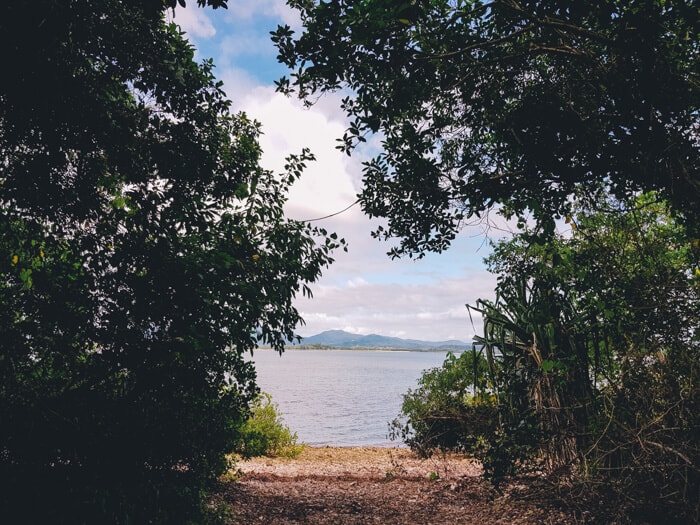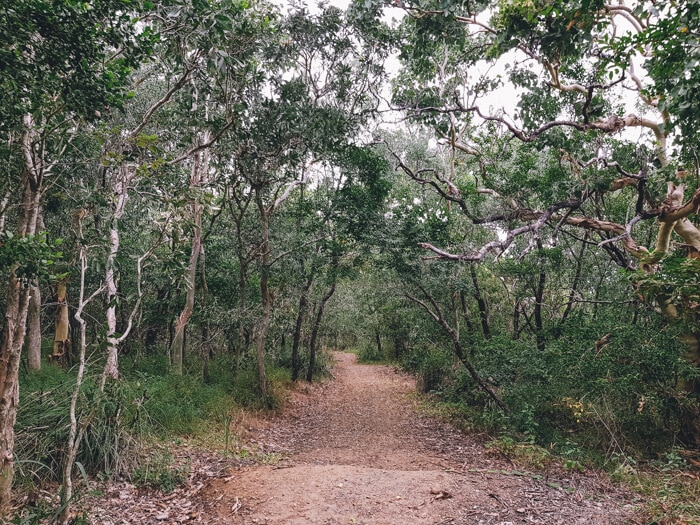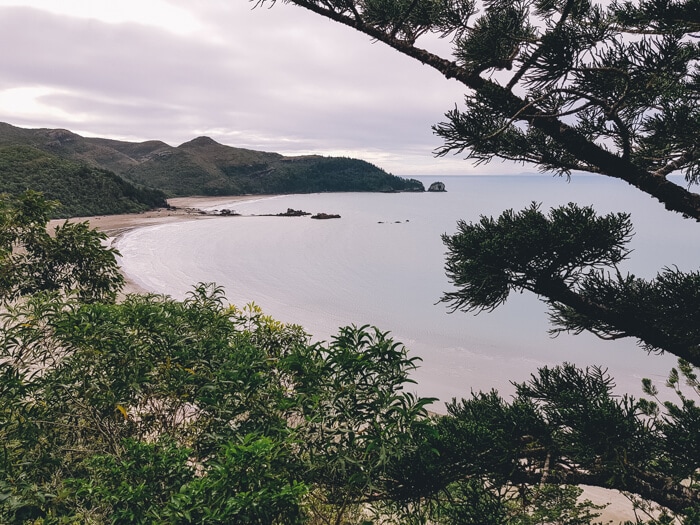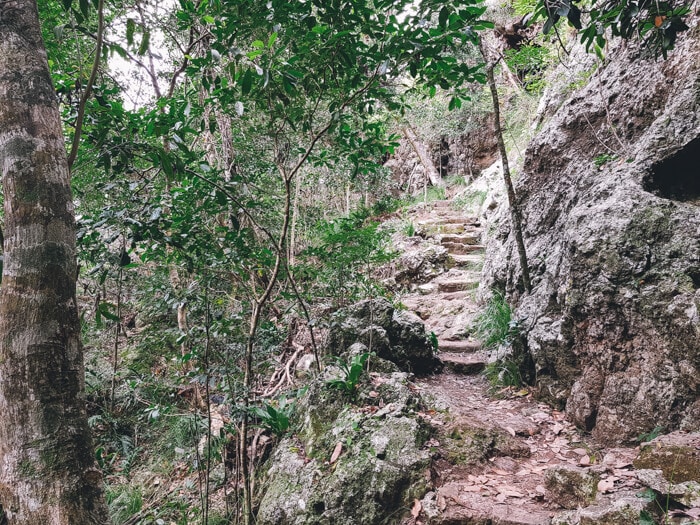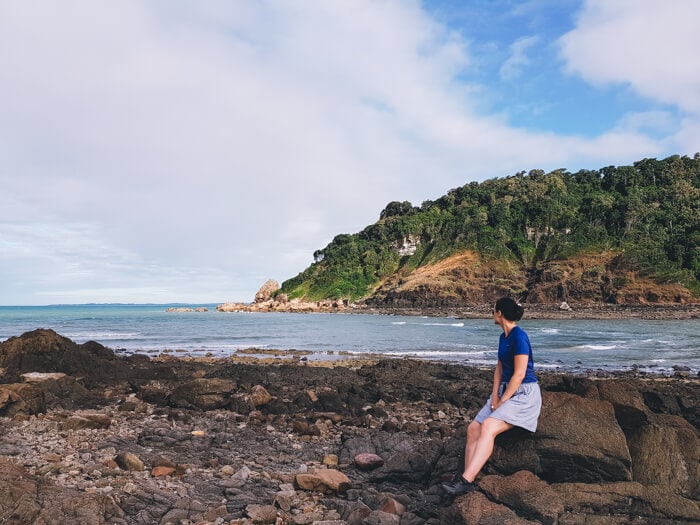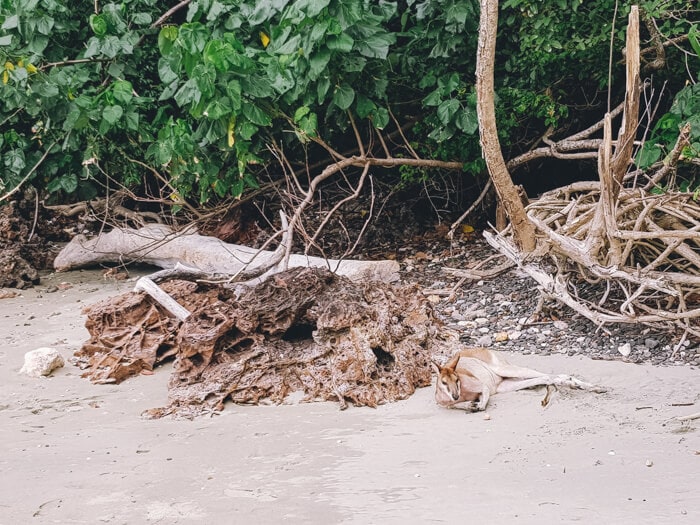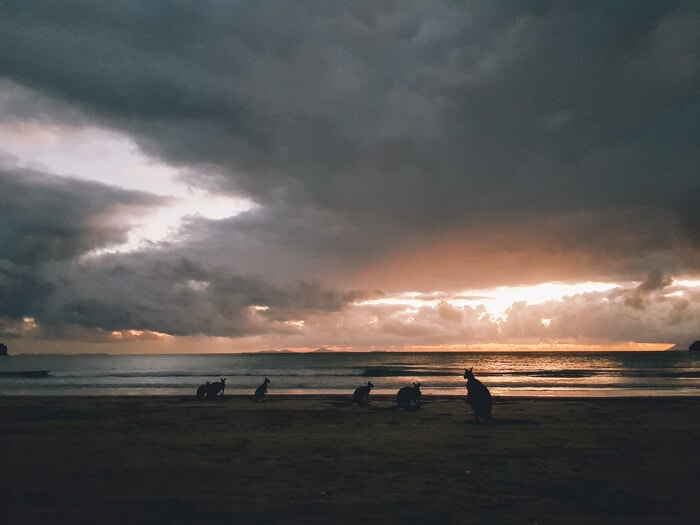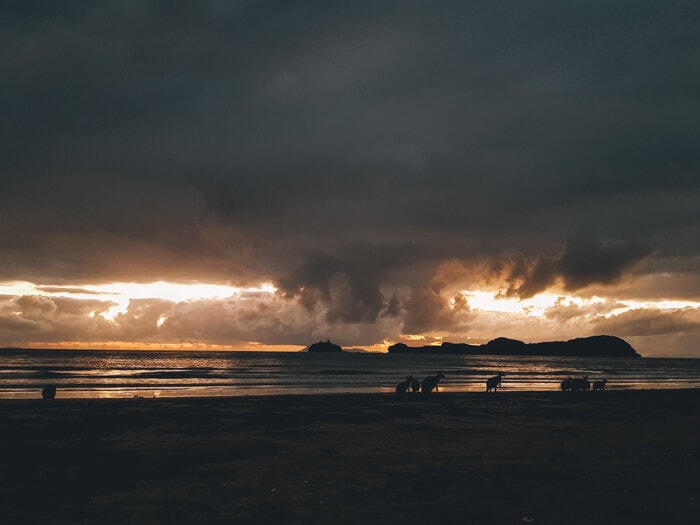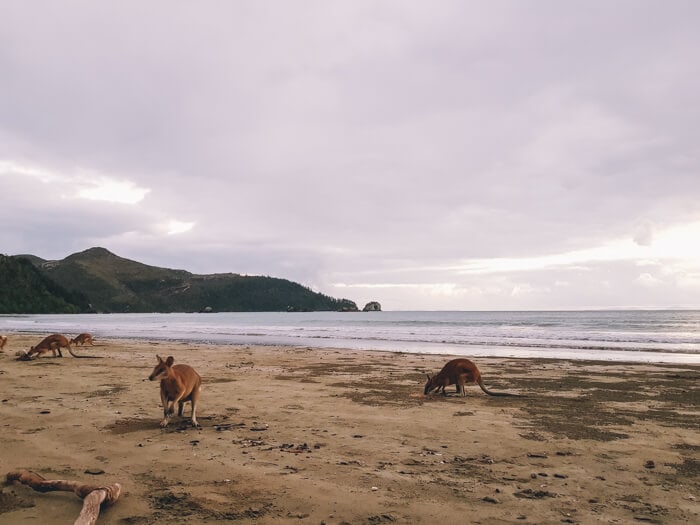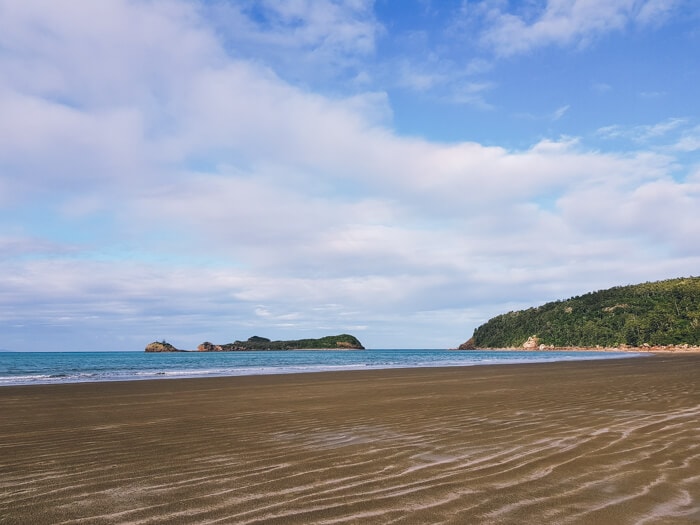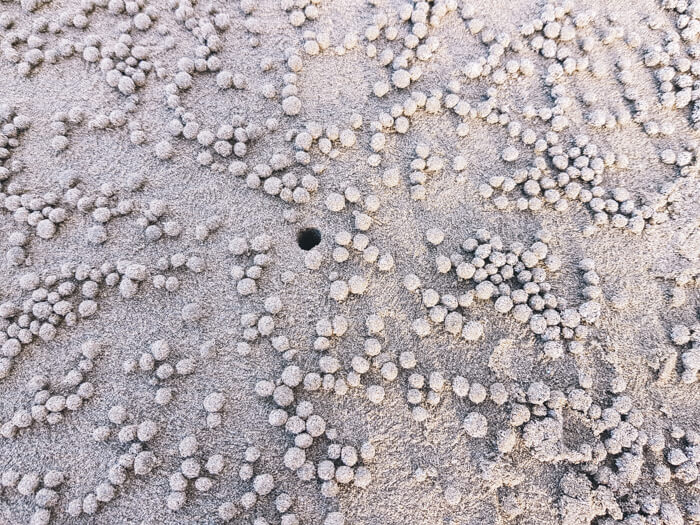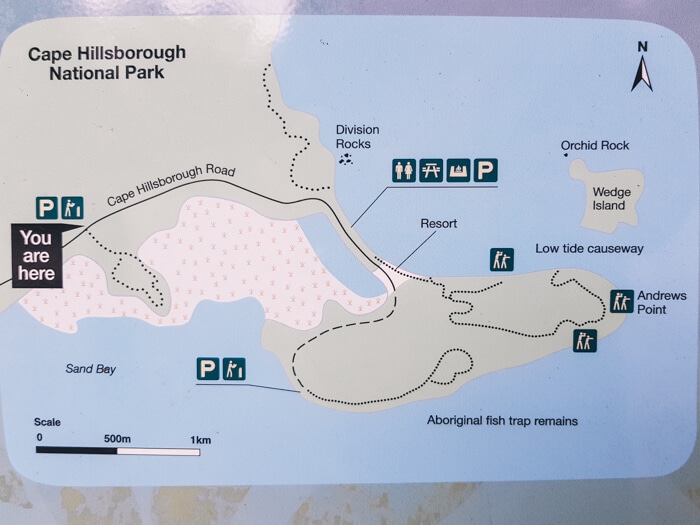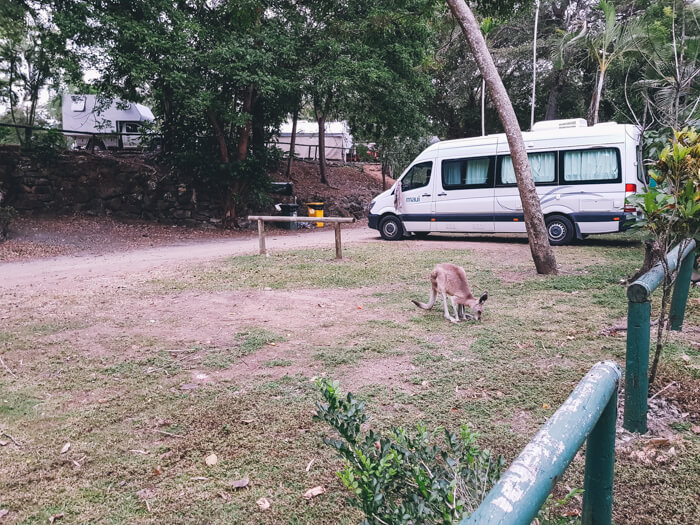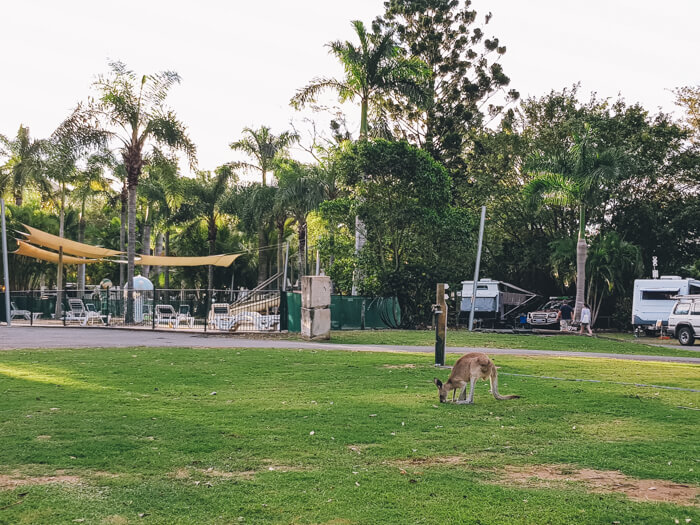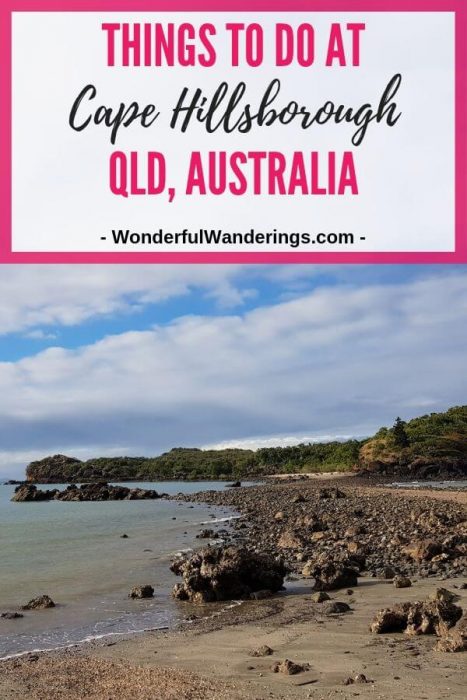Cape Hillsborough National Park is located on a peninsula north of Mackay and about 636 miles north of Brisbane in Queensland, Australia. It was a must-do on our road trip along the central Queensland coast as it’s known for its beach, where you can spot kangaroos and wallabies at sunrise.
But that’s not all you can do at Cape Hillsborough National Park. Below you can read how we spent our time there.
Contents
Things to do in Cape Hillsborough National Park
1. Go hiking at Cape Hillsborough National Park
There are four different walking tracks at Cape Hillsborough National Park:
- the Beachcomber Cove Track
- the Diversity Boardwalk
- the Andrews Point Track
- the Yuibera Plant Trail
Beachcomber Cove Track
The Beachcomber Cove Track was closed for maintenance when we were there, but if you’re interested in checking it out on your trip, you can find the start of it at the northern end of the Cape Hillsborough picnic area. From there, it supposedly goes through the eucalypt forest and rainforest before reaching a lookout point at Beachcomber Cove.
You can return to the picnic area via the beach at low tide. But at high tide, you need to walk the same way back. The hike is a 1.4 miles return and should take you about 1.5 hours.
Diversity Boardwalk
The Diversity Boardwalk is the first of the Cape Hillsborough walks we came across it while driving toward the beach. It’s a short 1300-yard round track and easily doable in 40 minutes or less.
The Diversity Boardwalk got its name from the wide variety of plants and (mostly small) wildlife you can see when walking it. The first part is the most fun, as it takes you over a wooden boardwalk from where you can see small crabs crawling through the mud below.
This part (only about 330 yards) is wheelchair accessible, but then after that, the boardwalk goes over into a dirt track. Along the way, signs indicate the meaning of specific plants for the native Yuibera aboriginal people.
Good to know:
There’s a free parking lot at the start of the track, which is to your right if you’re driving into the national park. Keep your eyes open for signs pointing to it.
Yuibera Plant Trail
The Yuibera Plan Trail is only a 1300-yard return hike, but to get there, you need to either walk or drive (only with regular cars) another 1300 yards along Hidden Valley Road behind the Nature Tourist Park. We didn’t know and thought the road behind the campsite was already the start of the trail.
So while the official time to do this hike is 40 minutes, it’s best to account for an hour or even a bit more. The track is easy to walk, and aside from the road to get there, which is a bit hilly, it’s not tiring.
We found this hike to be a bit disappointing. It does give insight into the use of plants by the Yuibera aboriginal people via information panels along the way, but we’d hope to get better views of the ocean as the track runs close to it.
Ah well, they can’t all be mind-blowing :-) I’m still glad we did it, as otherwise, I would’ve probably wondered if I missed out on something.
Andrews Point Track and Wedge Island
The Andrews Point Track is the longest and coolest hike at Cape Hillsborough National Park. It starts right behind the Nature Tourist Park, where we spent the night (more on that later), but you can also access it from Cape Hillsborough Beach.
The track climbs up quite a bit to then reward you with beautiful ocean views from several lookout points, of which Andrews Point is one. Once you’ve reached the end, you can return the same way to make it a 3.2-mile return walk or go down to the beach to walk back from there, which will total a 1.7-mile return.
Attention: the latter is only possible at low tide.
We hadn’t timed the Cape Hillsborough tides, so we got lucky to reach the end of the track at the right time. As we came down to the beach, we noticed you could also walk from the end of the path to Wedge Island.
Some people were fishing there, and Wedge Island also offers a nice view of Cape Hillsborough Beach.
It’s best to check Cape Hillsborough tide times at the Nature Tourist Park, as you won’t have phone reception there. But to give you an idea, we started this walk in the early afternoon. It was our favorite because of the changing scenery, the lookouts, and the animals we saw along the way.
In just the first 30 minutes or so, we spotted a rock wallaby and a massive spider! On, and then there was Molly the kangaroo.
If you want to avoid tide times, it’s also possible to kayak to Wedge Island.
2. Say hi to Molly, the resident kangaroo
Molly is a kangaroo that somehow ended up alone when she was still tiny, right by the Cape Hillsborough Nature Tourist Park. She quickly figured out she could get food at the campsite and stuck around.
We spotted Molly lazing at the beach right by the start of the Andrews Point Track. She clearly wasn’t bothered by us taking photos of her, but we kept a safe distance for ourselves, and so we didn’t disturb her.
Later that day, we saw her grazing on a patch of grass at the campsite. So cool!
3. Spot wallabies at sunrise
Cape Hillsborough Beach is also known as Cape Hillsborough Kangaroos Beach, but you’re more likely to see agile wallabies there than kangaroos – although they sometimes come and visit too. Both species feed on the seaweed and other things that wash ashore at night.
As people became aware of this, the word spread and the kangaroos and wallabies became Cape Hillsborough’s main attraction. To ensure the safety of the animals, a ranger now oversees their breakfast ritual every morning.
When we arrived at the beach, the ranger had marked off a line we needed to stay behind while watching the wallabies. She gave us some guidelines on how to keep the animals safe and shared information about them.
She was also the only one who could feed the wallabies. I was surprised that she did this because, while she explained she was only giving them things that are part of their natural diet, it conflicted with her saying that they want to keep these animals wild.
It turns out it’s a way to keep the tourists happy while making sure the animals are safe, well-fed, and returning every morning at the same time.
We spent a little less than an hour on the beach. My photos of the experience could be better as I only had my phone with me and also wanted to savor the moment more than capture it.
Good to know:
When we checked in at the Cape Hillsborough Nature Tourist Park, the receptionist told us when we’d have to get up to see the wallabies. Of course, the animals don’t set their clock, but they tend to get to the beach as soon as there’s a little bit of light. In June, that was at 6 a.m.
If you really can’t get up that early – but I highly recommend you do – you can also see the wallabies at the campsite or the picnic area. We spotted them several times and were there for less than 24 hours. It’s not quite the same as seeing them with the sun rising in the background, though :-)
Booking a “sunrise with the wallabies tour” is also possible. The only difference between the tour and going to the beach on your own that I noticed is that our people get a headset in which they receive information. I don’t know if there was a tour on in the morning when we were there, as the ranger present just spoke to everyone.
Plus, you can simply access the beach from the Nature Tourist Park if you’ve spent the night there.
4. Relax at the beach
I already mentioned the beach a few times. Aside from spotting wallabies at sunset, it’s also a great place for a relaxing stroll or to put your towel down and chill out.
When you do, make sure to keep an eye on the sand. The entire beach was dotted with tiny holes made by some kind of crab when we were there. Sometimes, you’d suddenly see one running sideways along the coast. It was pretty funny.
Apparently, you can sometimes also spot coral when the tide is low, but we didn’t read about that until after our visit, so we didn’t look for it.
5. Go fishing
You can even do a Cape Hillsborough fishing trip! We saw some people doing just that from the rocky headlands at Wedge Island when we returned from our hike to Andrews Point. You can also fish from the beach.
6. Have tea at the Old Station Tea House
This is the only thing I had planned at Cape Hillsborough that we didn’t end up doing simply because we weren’t really in the mood for food and drinks when we left the campsite – I know, it’s rare, but it does happen :D
As I did the research anyway, I thought I’d share it here with you.
The Old Station Tea House is literally that: a tea house inside an old train station. The owners, Michelle and Dwayne, moved from the town of Marion to Cape Hillsborough over 20 years ago. It’s a popular spot for morning tea, coffee, cake, or lunch.
Cape Hillsborough accommodation
1. Cape Hillsborough National Park camping area
There are two places where you can stay at Cape Hillsborough. One is the Smalleys Beach Camping Area, one of the many official Queensland park camps. To stay there, you have to pay a small fee of 7 AUD / 5 USD per night.
Good to know is that there’s practically no phone reception at Cape Hillsborough, so you’ll need to book a spot at Smalleys Beach Camping Area online beforehand, at an office or a self-serve kiosk. You can find more information about booking camping spots at Queensland’s national parks here.
Your other option is where we stayed: Cape Hillsborough Nature Tourist Park.
2. Cape Hillsborough Nature Tourist Park
The Cape Hillsborough Nature Tourist Park is a spacious campsite right by the beach. It has spots for motorhomes, camper vans, caravans, and different cabins and studio rooms for rent.
There are five bbq areas, two camp kitchens, three amenity blocks, a laundry area, a massage area, a meeting room, and an outdoor pool. There’s also a cafe where you can get drinks, snacks, and quick meals depending on the time of the day.
When the cafe is closed for service, you can still sit inside or on the terrace. There are things like board games, books, and puzzles to keep you entertained.
The cafe is also where the regular outdoor movie screening takes place.
While it has a lot to offer, the Cape Hillsborough Nature Tourist Park isn’t a massive campsite. We found it to be a good size: big enough to have ample room and small enough to walk from one side to the other in less than five minutes.
Plus, you can’t beat its direct access to two of Cape Hillsborough’s hiking trails as well as the beach, not to mention Molly the kangaroo and wallabies roaming the grounds!
Upon arrival at the Cape Hillsborough Tourist Park, they didn’t just show us our spot for the night but also gave us information about the Cape Hillsborough walking trails and the sunrise wallaby experience. We also got a handy brochure detailing things to do in the surroundings.
We loved our night there. If you don’t mind that there’s not much else to do besides the things I mentioned above, it would also be an excellent place to spend a few nights just to hang out and relax.
Read more reviews on TripAdvisor
Go Have fun at Cape Hillsborough National Park
Whether you stay at Cape Hillsborough Resort, in a tent at Smalleys Beach, or in one of the Cape Hillsborough cabins, you’ll undoubtedly have an unforgettable stay at this stunning location.
Don’t forget travel insurance
No matter how well you plan your getaway, something unexpected can always happen. A reservation can get canceled, you can get sick, or you can drop and break that new camera. In all of these cases, good travel insurance has you covered.
I’ve had ongoing travel insurance ever since I started traveling to make sure I’m covered for every trip I go on, but if you travel just a few times a year, you can get insured for each trip separately too.
Don’t have travel insurance yet? Check out SafetyWing. They offer super flexible plans that you can even sign up for while you’re already on your trip. On top of that, they were the first travel insurance to cover COVID, and when I got COVID, they reimbursed all of my expenses without making a fuss. Their customer support team is great, and I can personally recommend them.
PIN FOR LATER

